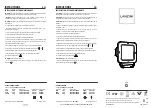
- 49 -
Glycol concentration measurement
– To optimise the unique engine protection features
of the PARCOOL EG the concentration of the
Glycol in the water should be always above
33 vol.%.
– Mixtures with more than 68 vol.% mix ratio in
water are not recommended, as this will lead to
high engine operating temperatures.
– A refractometer can be ordered from Atlas Copco
with part number 2913 0028 00.
5.4.4.3
Topping up of coolant
– Verify if the engine cooling system is in a good
condition (no leaks, clean,...).
– Check the condition of the coolant.
– If the condition of the coolant is outside the limits,
the complete coolant should be replaced (see
section “Replacing the coolant”).
– Always top-up with PARCOOL EG.
– Topping up the coolant with water only, changes
the concentration of additives and is therefore not
allowed.
– Additives might be necessary in order to enable
the coolant to withstand lower temperatures.
5.4.4.4
Replacing the coolant
Drain
– Completely drain the entire cooling system.
– Used coolant must be disposed or recycled in
accordance with laws and local regulations.
Flush
– Flush twice with clean water. Used coolant must
be disposed or recycled in accordance with laws
and local regulations.
– From the Atlas Copco Instruction book, determine
the amount of PARCOOL EG required and pour
into the radiator top tank.
– It should be clearly understood that the risk for
contamination is reduced in case of proper
cleaning.
– In case a certain content of ‘other’ coolant remains
in the system, the coolant with the lowest
properties influences the quality of the ‘mixed’
coolant.
Fill
– To assure proper operation and the release of
trapped air, run the engine until normal engine
operation temperature is reached. Turn off the
engine and allow to cool.
– Re-check coolant level and add if necessary.
5.5
Adjustments and service
procedures
5.5.1
Battery care
If the battery is still dry, it must be activated as
described in section “Activating a dry-charged
battery”.
The battery must be in operation within 2 months
from being activated; if not, it needs to be recharged
first.
5.5.1.1
Electrolyte
Electrolyte in batteries is a sulphuric acid solution in
distilled water.
The solution must be made up before being
introduced into the battery.
In case of a mix of different coolant
products this type of measurement
might provide incorrect values.
Before handling batteries, read the
relevant safety precautions and act
accordingly.
Always wear protective gloves and
goggles when handling the battery -
battery fluid contains sulphuric acid
that can cause burns. If your skin or
your clothes come in contact with the
battery fluid, rinse immediately with
plenty of water. If even a tiny
quantity is swallowed, seek
immediate medical help.
Read the safety instructions
carefully.
00_00_HiLight H4_EN.book Page 49 Monday, April 18, 2016 2:10 PM
Содержание HiLight H4 Kd ESF
Страница 2: ...00_00_HiLight H4_EN book Page 2 Monday April 18 2016 2 10 PM ...
Страница 76: ... 76 10 3 Average illumination versus distance 00_00_HiLight H4_EN book Page 76 Monday April 18 2016 2 10 PM ...
Страница 81: ... 81 Circuit diagrams 00_00_HiLight H4_EN book Page 81 Monday April 18 2016 2 10 PM ...
Страница 85: ... 85 00_00_HiLight H4_EN book Page 85 Monday April 18 2016 2 10 PM ...
Страница 90: ... 90 00_00_HiLight H4_EN book Page 90 Monday April 18 2016 2 10 PM ...
Страница 93: ...00_00_HiLight H4_EN book Page 93 Monday April 18 2016 2 10 PM ...
Страница 94: ......
















































